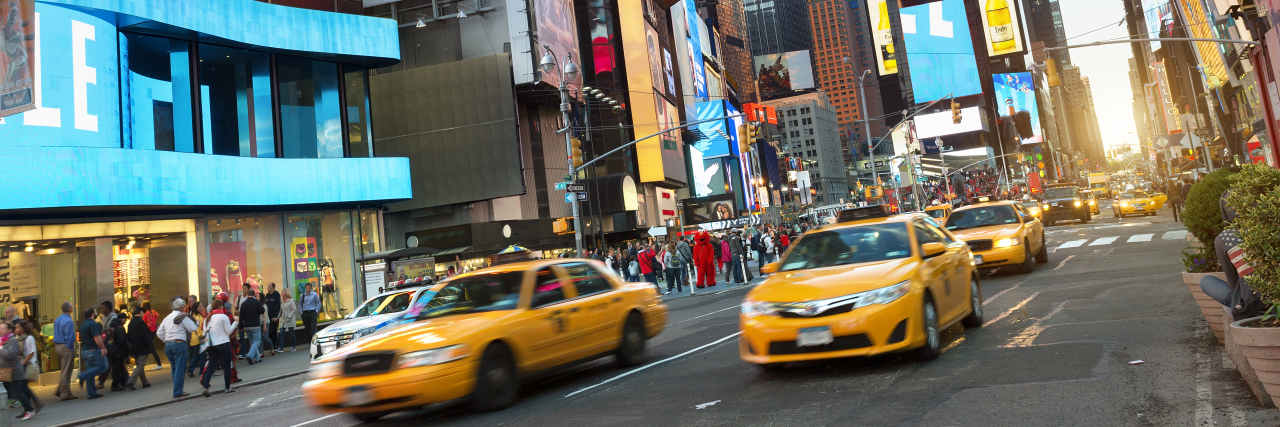I walked out of my hotel room and started in the direction of Grand Central Station to meet Reid Davenport for the first time.
I’d been to New York several times in my life, but never with such a clear sense of purpose. Reid, a veteran documentary filmmaker, was undertaking a new project with me about accessible transportation in New York. I wasn’t a filmmaker. I didn’t have any physical disability that made using a mobility aid like a wheelchair necessary. But I worked for BraunAbility, a company responsible for many of the accessible taxis that were slowly becoming more common on New York City streets. I’d obsessed over the inequality in transportation every day at my job as a marketer and this, finally, was something I could do to make a difference. Maybe.
Google Maps was guiding me with blue dots up main stretches, down side streets and blocks past my actual destination. I started to wonder how much more stressful this might feel if I were in a power chair that depended on the life of a battery. The cold was starting to set into my bones. I could have arrived here without incidence had I called a taxi. But I wanted to know what it was like – really like – for someone in a wheelchair, as much as possible. Because for half a million New Yorkers, this was every day. Taxis weren’t exactly an option. Or subways. Or ride-share vehicles like Uber and Lyft.
Reid and I met in a bar at the station. It was the night before we did our first interview. The station was busy, as it always is. Most of the tables were taken, but we secured a spot where Reid could maneuver his rental wheelchair up to a table comfortably. This wasn’t the last time we’d need to look around a place to ensure Reid would be able to get into a business and be comfortable at a table. I started practicing my glare at the faces who would turn to look at the chair with curious eyes like they were at a zoo or window shopping. We took swigs of our beer and shut the world out for a while as we planned meeting times and other details.
Our own cameraman, Jason, and sound guy, Enrique, admitted they knew very little about the fight surrounding accessible taxis and the continued resistance toward full integration in the city despite being New Yorkers themselves.
In the climax of the trip, our foursome decided to split up to reconvene at the Three World Trade Center, a fitting symbol of freedom that would be ideal for the film. Enrique and I took a majority of the heavy sound and lighting equipment with us in a taxi while Jason and Reid took the subway armed with a single camera. Enrique and I sat in the lobby of a hotel for over an hour and agreed that Reid and Jason should have definitely been there by then. We obsessively checked our phones for messages or calls.
Finally, one came. Reid was going home. The Chambers Street station didn’t have an elevator to the street and with a two-hour train trip home, he didn’t have time to get a connection to another station a block away. After the trip, we would learn that the Chambers Street station is actually three separate stations all by the same name and only one was accessible. Our symbol of hopeful freedom was never captured on camera.
This film we created, “Access Denied,” is not about art, or winning awards, or even being praised. It’s about teaching people like Jason and Enrique that there’s a fight going on right in their backyard, and they can play a role in changing things. It’s about showing people like me a glimpse of what it’s like to be Reid and struggle just to do simple things like meet friends for dinner or see an American landmark. Really, it’s about changing people’s attitudes about what is right.
“Access Denied” illustrates what methods of transportation are available to people in wheelchairs currently. It also shows how each of those methods have asterisks at the end with a subtext of “limited availability,” “previous appointment necessary,” or “use at your own risk.” Proponents of accessible transportation “victories” in the past will say wanting accessible taxis is frivolous and an expensive burden to place on the city. But as we all know, transportation needs aren’t just from 9-5 in certain areas of the city, and it shouldn’t be treated that way.
There is unapologetic truth in this film. It’s a film my company, BraunAbility, sponsored because we believed in the cause. It may anger some people and others will talk about a political agenda as if equal rights are somehow politically polarizing. But it’s a film that begged to be made, and I for one am not sorry.
It’s my hope that people will share this story about the lawyers, Emmy-award winning documentarians, wives, husbands, taxi drivers, advocates and friends impacted by this problem. This story isn’t about just one person, but if one person, and then another, and then another, decides to share this film and keep the conversation for equal rights going, there’s a real chance we can push progress. And then maybe next time Reid and I visit New York City, there won’t be anywhere we can’t go together.
We want to hear your story. Become a Mighty contributor here.
Getty image by John Kellerman.

